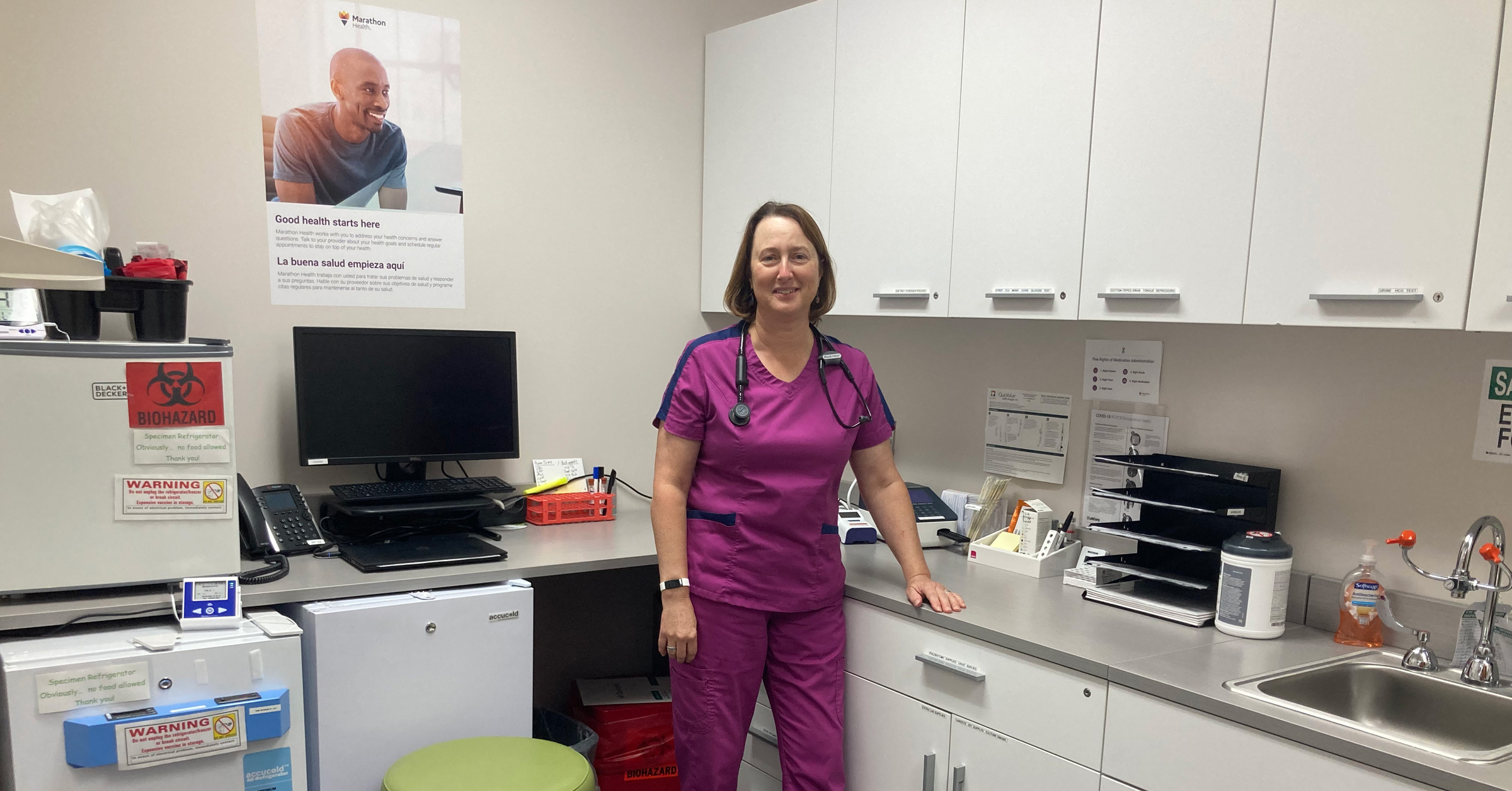Marathon Health’s one-on-one series highlights the role different care providers play in improving employee health at the worksite, at a nearby Network health center or virtually. In this blog, I visited Family Nurse Practitioner and Health Coach Linnea Ritter, who has worked in healthcare for over 30 years.
A typical day for Family Nurse Practitioner and Health Coach Linnea Ritter varies depending on patient needs at the employer-sponsored Cretex Companies Be Well Health Center in Coon Rapids, Minnesota.
She might be freezing off plantar warts, making outreach calls, or even announcing a pregnancy to a patient. “That’s really fun.” she says. “Usually, they’ve taken a home test and want confirmation. I always say, ‘There are no false positives, only false negatives.’”
Whether seeing sniffles, sore throats or broken bones (it happens), or helping employees overcome high cholesterol, lower their blood sugar or stop smoking, Linnea enjoys individualizing care to devise a treatment plan that works for the patient.
Personalizing Employee Healthcare
Ritter worked in geriatric care for a few years before a life change moved her back into family practice.
“I was pretty distressed by the pace when I went back to it,” she says. “Because all the appointments were 20 minutes — whether it was a physical, abdominal pain, chest pain — it didn’t matter, it was 20 minutes. There just wasn’t enough time to address everything.”
One of the many aspects Ritter appreciates about her role with Marathon Health is the ability to take her time with patients and focus proactively on wellness. Each appointment is allocated a half-hour minimum. Preventive visits are free and patients only pay a $20 copay per visit.
“Our philosophy is much more preventive, and it’s population health-focused,” she says. “So you’re preventing diseases; you’re getting on top of things before they become a problem.”
This approach proved itself when a patient came in for routine lab work and presented with an A1c of 13. For reference, an A1c between 5.7 to 6.5% represents prediabetes, and 6.5% or higher puts someone in the diabetic category.
“He was in his 30s and had high blood pressure, elevated liver enzymes, blood sugar levels, and cholesterol — he was on his way to developing heart disease,” Ritter says.
Ritter and the patient discussed options, and the patient wanted to try lifestyle changes before using medicine. Since an onsite health center affords employees the opportunity to visit as often as they need to, Ritter agreed, so long as he came back weekly for labs monitoring.
“So we brought him back weekly for blood sugar checks, and he was consistently bringing those numbers down,” Ritter says. “He lost about 60 pounds and got himself into the normal range on all metrics — with only lifestyle changes.”
Ritter notes that wouldn’t have been possible in traditional primary care.
“In primary care, the person might not visit again,” she says. “So if you don’t put them on medicine, it could be much worse in six months to a year.”
Providing Patient Navigation for Employees
For anything not able to be treated within the center, Ritter helps patients find the right place to go.
“I’ve had some patients with broken bones,” she says. “I don’t have an X-ray machine here, but I have a relationship with Midwest Radiology. I just send the referral and patient right over, and they can walk in for an X-ray any day before 8 p.m. The radiologists read those films for me right away.”
In addition, Ritter notes she typically sets up a CT scan for a patient within a day or two. She also nurtures relationships with neurology and ear, nose and throat specialists, among other specialties. “If it’s out of the family practice realm, I help get the patient where they need to be,” Ritter says. “A lot of times, people don’t know where to go, so I can be that funnel.”
Engaging and Empowering Employees for Better Health
Cretex employs more than 2,500 people. Off-site workers have access to the center and often schedule virtual visits. Any employee, regardless of whether they participate in a Cretex health insurance plan, can visit the health center. For employees opted into Cretex health insurance plans, family members can be seen as well.
Ritter and Medical Assistant Danielle Bryant visited worksites in Bloomington, Brooklyn Park, Anoka and Dassel, Minnesota, in June to discuss nutrition and cardiovascular disease prevention as outreach to encourage more employees to visit the center. They plan to repeat the process in October. Ritter also regularly makes phone calls to check in on employees who haven’t visited the center for a while.
At the Coon Rapids location, 56% of employees are preventively engaged with the wellness center, and 72% of the high-risk employees are engaged, compared to 36% and 51%, respectively, for employees working off-site from the Coon Rapids campus.
“If I can get them through the door for a cold or runny nose, it gives me an opportunity to discuss preventive care,” Ritter says.
From there, she sets the patient up for labs and any age-related procedures, like mammograms or colonoscopies. “When you help people make positive lifestyle changes, and you get to see the results, that’s really rewarding,” Ritter says.
She recommends all employees take advantage of their employer-sponsored health center. “It’s convenient and personalized to them,” she says. “I field so many questions. It’s like having a medical professional at your service.”
You might also like
Subscribe to our newsletter and stay on the cutting edge of worksite healthcare.










